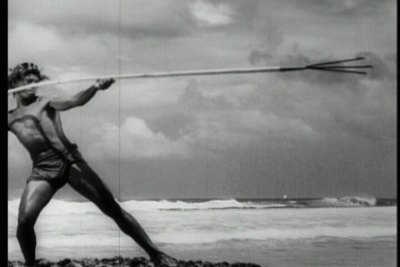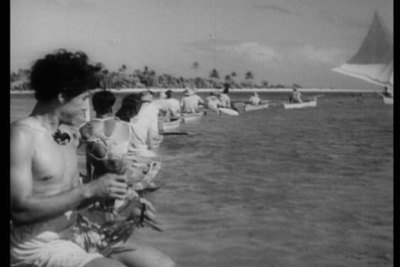| Reviews & Columns |
|
Reviews DVD TV on DVD Blu-ray 4K UHD International DVDs In Theaters Reviews by Studio Video Games Features Collector Series DVDs Easter Egg Database Interviews DVD Talk Radio Feature Articles Columns Anime Talk DVD Savant Horror DVDs The M.O.D. Squad Art House HD Talk Silent DVD
|
DVD Talk Forum |
|
|
| Resources |
|
DVD Price Search Customer Service #'s RCE Info Links |
|
Columns
|
|
|
Tabu (Kino)
 When Murnau arrived in Hollywood under contract with Fox Studios, he went to work on Sunrise, he was left to his own devices, for the most part, and the film went on to win three Oscars in the 1929 Academy Awards. He then did two other films for Fox, with an increasingly larger amount of studio input. Input that he neither needed nor wanted. After filming was completed, it was announced that both of these films, Four Devils and City Girl, were going to have scenes reshot to add sound. The reshoots to be directed by a sound engineer, with no input from Murnau. This was all he could take, and he bought out his contract.
When Murnau arrived in Hollywood under contract with Fox Studios, he went to work on Sunrise, he was left to his own devices, for the most part, and the film went on to win three Oscars in the 1929 Academy Awards. He then did two other films for Fox, with an increasingly larger amount of studio input. Input that he neither needed nor wanted. After filming was completed, it was announced that both of these films, Four Devils and City Girl, were going to have scenes reshot to add sound. The reshoots to be directed by a sound engineer, with no input from Murnau. This was all he could take, and he bought out his contract.
Murnau then spent some time learning to sail, and bought a 65 foot yacht. He was still interested in film though, but didn't want the studio to be able to dictate to him how to make his films. So he formed a film production company with documentary film maker Robert J. Flaherty (Nanook of the North, Man of Aran,) both filmmakers being equal partners. The pair decided to film a movie in Tahiti. They would move to the island, spend some time living there, and developed a story involving the native people. They singed a deal with a company Colorart to back the film and set off for the south seas.
No sooner had they arrived then problems began. Colorart had not sent the film stock and money that was promised. After months of cables back and forth, it was decided that Murnau would finance the film himself.
The two worked well together for a time. They outlined a basic plot and worked on the story. They found native actors to fill the major roles. But there was tension. With Murnau bankrolling the film with his own savings, they were no longer equal. Their styles were very different. As where Murnau was trained in the studio system making dramas, Flaherty was self taught and documentaries. Flaherty's style was to shoot miles of film and then piece something together in the editing room. The frugal Murnau did not like that at all. Eventually things came to a head, and Murnau bought out Flaherty at the latter's request.
 The two were able to create a story involving the native culture, but not a documentary. The cultural and religious beliefs that they illustrated were no longer in practice when the movie was made, but they had only died out recently, and there were still people who remembered the old ways.
The two were able to create a story involving the native culture, but not a documentary. The cultural and religious beliefs that they illustrated were no longer in practice when the movie was made, but they had only died out recently, and there were still people who remembered the old ways.
The story centers around a young couple, Reri and her boyfriend Matahi. They are in love but something happens that threatens their future. A schooner sails into the harbor carrying Hitu, the representative of the "king of all the islands." He brings news that the sacred maiden has died, and that a new one must be chosen. The king has selected Reri because of her beauty and purity. From that day forth, no man may touch her or think of her with lust. She is Tabu.
That night Matahi sneaks aboard the ship, and steals Reri away. They run to an island controlled by the white man, where the tribal will not be able to harm them. But they didn't count on being trapped by the new customs that they encounter there.
This film is woven together very gracefully. The relationship between the couple being trapped by old beliefs and them being trapped by the monetary society that they enter was well done and not heavy handed. The movie could have easily digressing into sappy melodrama, but it doesn't.
While lacking the resources of a large studio picture this is still a masterful film. There are no elaborate special effects or interesting camera movement that had populated his earlier works, but Murnau proved that he didn't need those to make an interesting picture. The scenery is a beautiful backdrop, and responsible for some lovely shots, but the editing really tells this story well.
The DVD:
Audio:
The audio for this movie is a musical track in mono. There is a lot of hiss present, and the sound is rather flat and thin. The track is rather old, and not a lot has been done to it. It is acceptable, but not by much.
Video:
The video for this DVD was taken from a preservation negative. The quality was pretty good overall. There was some print damage, as you will find in any film this old, but they were minor. There was very little speckling and dirt on the print, but the picture was very soft and slightly blurry. There are a couple of instances with unstable frames also. A nice, if somewhat too soft, picture.
The Extras:
There is a good number of extras on this disc that really enhance the package.
Commentary: Professor Janet Bergstrom from UCLA provides a full length commentary for the film. Her comments were very informative and interesting. She talked about the history of the production, the troubles that occurred between Murnau and Flaherty, and gave a brief biographies of the filmmakers. As the film went on, she had less background to give, and her scene specific comments, while welcome, restated what was happening on screen a little to much. Aside from that minor criticism, a quality commentary.
Outtakes: 23 minutes of unused footage from the film, with narration by Janet Bergstrom. She talked more in detail about problems Murnau and Flaherty had with the company that put up the money for the film, Colorart.
Reri in New York: After the success of Tabu, the young actress who started in the film found herself an international star. She went to the states, and preformed in the 1931 Ziegfeld Follies. This film footage looks like it was from a screen test that she did while in New York. She is older, and this footage show her walking through the park, and feeding birds. The 3 ½ minute reel is narrated by Janet Bergstrom who gives details of Reri's life after the film. An interesting commentary and film reel.
In addition to these features, there is also a theatrical trailer, still gallery with many production and on the scene photos, and script excepts in .pdf format that can be viewed on a computer with a DVD-Rom drive.
Final Thoughts:
Some have called Tabu Murnau's best work. While I feel that this last film is excellent, I think some of his previous work was stronger. Tabu does illustrate what a powerful filmmaker Murnau was even without a large studio or big budget. This uncomplicated film, almost archetypical in its simplicity, is still moving and engrossing. It is one of the last great silent movies (along with Chaplin's City Lights.) The fine print, though a little too soft, makes this a great addition to any silent film collection. Recommended.
|
| Popular Reviews |
| Sponsored Links |
|
|
| Sponsored Links |
|
|
| Release List | Reviews | Shop | Newsletter | Forum | DVD Giveaways | Blu-Ray | Advertise |
|
Copyright 2024 DVDTalk.com All Rights Reserved. Legal Info, Privacy Policy, Terms of Use,
Manage Preferences,
Your Privacy Choices | |||||||














